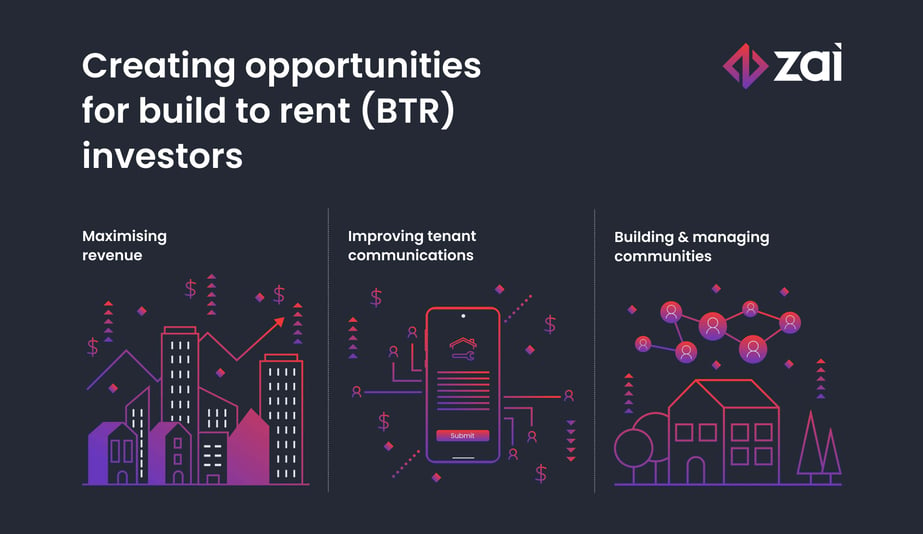As the name suggests, the build to rent (BTR) sector focuses on the construction of new homes specifically for renters rather than buyers. In the UK, this market is on the rise and shows no signs of slowing. The supply of BTR homes has increased by over 50% year on year since 2015. In 2021, there were 63,950 completed BTR homes available across the UK with 42,000 homes under construction and a further 99,500 in the planning stage. The sector is also benefiting from significant funding - investment into the UK’s build to rent market was over £4bn in 2021, making BTR the fastest growing sector in the UK’s property market.
The shift towards BTR is the result of a number of factors. The UK has long faced a housing shortage and, despite government efforts, supply is still not enough to meet demand. Covid-19 lockdowns further increased demand on the rental market in specific areas, as people living in small city flats moved to larger properties in suburban areas, with tenants placing more importance on communities and local amenities than ever before. Professionally managed, purpose-built rental accommodation fulfils this need for affordable housing within a ready-made community.
However, there are some major challenges facing the BTR sector in the UK. This article examines some of the key pain points and how UK proptech companies are offering solutions.
Challenge 1: Maximising revenue
How to increase rental yield
Rapid tenant turnover within the rental market often results in empty properties and lost income. Once a B2C property management company with a portfolio of their own, London proptech Lavanda recognised the opportunities within this market and pivoted to serve BTR operators directly. Their multifamily product uses technology and data to identify and help operators fill empty homes and maximise occupancy, removing 72% of all vacant units across their clients’ multifamily properties.
Yardi’s Voyager Residential product also allows BTR operators to centralise and streamline their end-to-end operational management. Their customers use data provided by Yardi to display availability of homes, reduce steps in the applicant’s journey, decrease empty units and boost cash flow and revenue.
How to improve lead generation and management
A further challenge within the sector is the time it takes from “leasing up” (the period before the building is completed) to “stabilisation” (95% occupancy). If leasing up takes too long, developers can face major cash flow challenges.
A 2019 report by London proptech Home Made reveals that a key pain point for BTR operators is how to fill their units with quality residents, while also maintaining their expected revenue per property. In the past, BTR operators needed to either source leads themselves at great cost, or go through local or national agencies. Home Made offers new, cost-effective ways to find the right tenants, let properties fast, increase estimated rental value and improve the tenant experience. Its unique approach combines proprietary rental data with an effective cross-channel marketing strategy to generate scalable demand for BTR properties.
How to reduce fraud
Tenant fraud is another major issue that reduces revenue within this sector. Data shows that 1.5% of all tenant applications are fraudulent. Evicting a rogue tenant can cost over £31,000. BTR rental fraud also increased by 364% in 2021. Working with fellow UK proptech flatfair, Homeppl offers tenant referencing services that combine fraud detection tests with behavioural analysis and open banking algorithms. The result is more fraudsters identified at an early stage in the application process and £1bn in revenue saved.
Challenge 2: Improving tenant communications
Many BTR companies experience issues communicating with tenants and assessing their satisfaction levels. Traditionally, announcements were delivered door-to-door, wasting staff’s time and leaving property managers unsure as to whether residents received the messages. Proptech solutions such as Yardi’s RentCafe have stepped in to allow BTR businesses to stay in constant contact with tenants. Property managers can use an app to easily communicate with tenants and proactively address issues in real-time. Residents have an easy way to log requests for repairs or complaints on their terms, resulting in higher tenant satisfaction and retention.
Challenge 3: Building and managing communities
In the wake of Covid-19 lockdowns, more tenants are looking for a sense of community where they live, as well as facilities such as gyms, open communal spaces, secure parcel rooms and concierge services. Many BTR operators experience challenges in delivering these amenities at scale, relying on manual processes and costly on-site staff. For example, a tenant wishing to book a gym slot or collect a parcel needed to liaise with the building management team during their limited working hours. Not only was this expensive for BTR companies to manage, but 92% of residents prefer digital communication and want to handle these tasks at their own convenience.
In order to address this issue, UK proptech Spike developed a tenant portal called Spike Living alongside their property management tool, connecting residents within the community and allowing for information on local amenities and activities to be shared.
BTR set to boom
Despite its rapid growth over the past few years, the BTR sector is still relatively young. Get Living London welcomed its first resident to its Olympic Village scheme in 2013, marking the birth of BTR in the UK. Within nine years, there are now over 200,000 BTR homes either completed, under construction, or in the planning stage. The sector shows huge potential for even further growth - recent research indicates that it could increase 10-fold in size.
Proptech companies will seek to capitalise on this BTR investment and we can expect to see more UK startups emerging. We will also see more collaborations between proptech businesses such as the one between flatfair and Homeppl, as well as more acquisitions as proptech companies grow and expand their offerings. The bottom line is that UK BTR is a growing sector and will continue to rely on proptech firms and the solutions they provide to tackle pain points, as they arise, while allowing them to scale quickly and efficiently.
At Zai, we'll be providing the payment solutions proptech companies need to succeed in BTR and other property sectors. Zai’s payment APIs help businesses manage multiple payment workflows and move funds, so they can pay and get paid without delays. We go beyond integrating several payment types and apply our real time expertise to a reliable micro-service architecture that powers your payment workflows. Using APIs, we enable authentication, liquidity, payment and settlement with zero wait-times.
To find out more, get in touch. To find out more about how you can improve the tenant-landlord experience, download the guide below.


.png?width=212&name=Cover%20(4).png)


